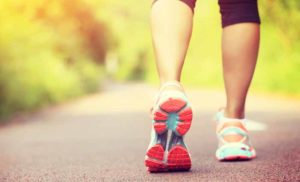A popular physical activity among adults, walking is inexpensive and requires no special equipment.
 Walking is one of the easiest forms of exercise – and one of the most enjoyable among adults, according to the National Institute of Diabetes and Digestive and Kidney Diseases (NIDDK). It is an easy way to become more active and can lead to a number of health benefits, including:
Walking is one of the easiest forms of exercise – and one of the most enjoyable among adults, according to the National Institute of Diabetes and Digestive and Kidney Diseases (NIDDK). It is an easy way to become more active and can lead to a number of health benefits, including:
- Lowering one’s risk of health problems, such as high blood pressure, heart disease, and diabetes
- Strengthening bones and muscles
- Burning calories
- Enhancing one’s mood
Most people do not need to see a doctor before they start a walking program, according to NIDDK. However, those who answer “yes” to any of the questions below are advised to check with their doctor first.
- Has your doctor told you that you have heart trouble, diabetes, or asthma?
- When you are physically active, do you have pains in your chest, neck, shoulder, or arm?
- Do you often feel faint or have dizzy spells?
- Do you feel very breathless after physical activity?
- Do you have bone or joint problems, such as arthritis, that make it difficult for you to walk?
- Are you over 40 years old, and have you recently been inactive?
- Do you have a health problem that might keep you from starting a walking program?
Making – and sticking to – a routine can be motivating for novice walkers. Things to consider are:
- Where will you walk?
- How often will you walk?
- Who will walk with you?
- How far or for how long will you walk?
In addition, be sure to dress properly. This includes:
- Shoes with proper arch support, a firm heel, and thick, flexible soles.
- Clothes that keep you dry and comfortable.
- A hat or visor for the sun, sunscreen and sunglasses.
- A hat and scarf to cover your head and ears when it’s cold outside.
NIKKD recommends dividing one’s walk into three parts:
- Warm up by walking slowly.
- Increase your speed to a brisk walk. This means walking fast enough to raise your heart rate, while still being able to speak and breathe easily.
- Cool down by slowing down your pace.
When walking, be sure to use proper form, keep your chin up and shoulders slightly back. Point your toes forward and let the heel of your foot touch the ground first, rolling your weight forward. Swing your arms naturally.
And, safety is important, beginning with stretching exercises. Most experts advise stretching only after you have warmed up. To warm up, walk slowly for a few minutes before picking up the pace. Stretching gently at the end of a walk may help build flexibility. Do not bounce or hold your breath when you stretch. Do each stretch slowly and move only as far as you feel comfortable.
In addition:
- Walk with others, when possible, and take a phone and ID with you.
- Let your family and friends know your walking time and route.
- If it is dark outside, wear a reflective vest or brightly colored clothing.
- Be aware of your surroundings.
About 150 minutes of moderate-intensity aerobic activity (activity that speeds up your heart rate and breathing) is recommended weekly to stay healthy. For more health benefits and to control your weight, you may need to walk more. NIKKD recommends walking about 300 minutes each week, or about 1 hour a day for five days. The more one walks, the greater the health benefits.